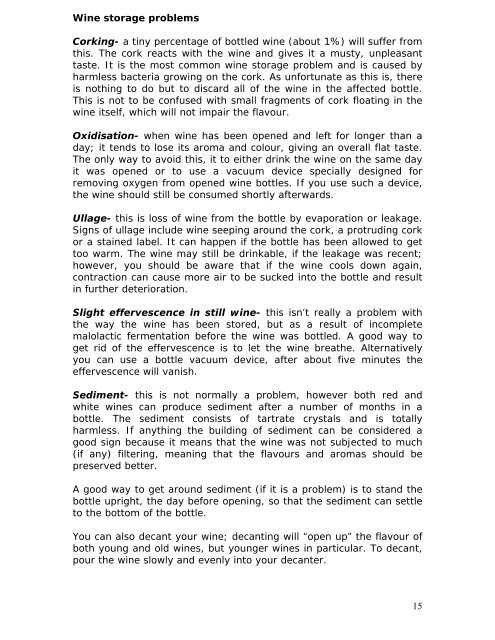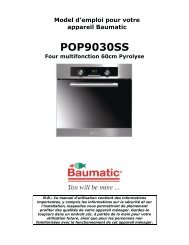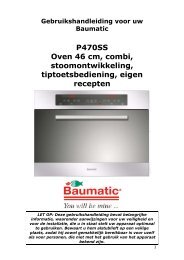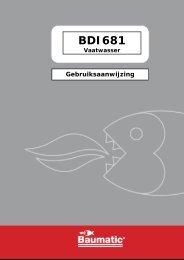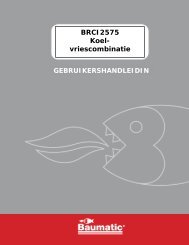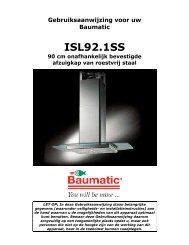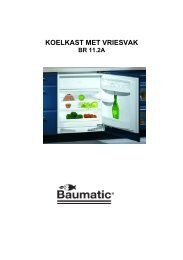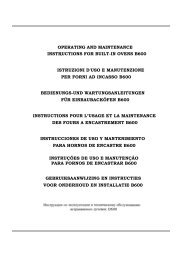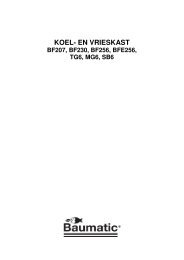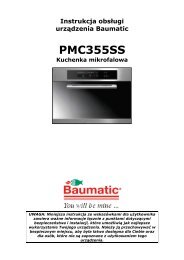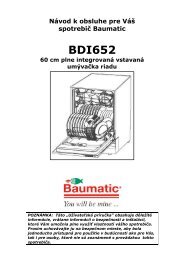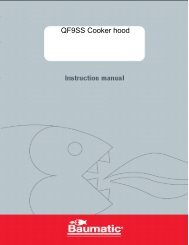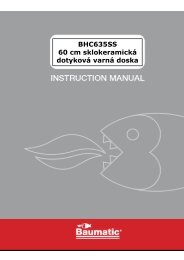BWC300SS 30 cm 18 Bottle built- in wine cabinet - Baumatic
BWC300SS 30 cm 18 Bottle built- in wine cabinet - Baumatic
BWC300SS 30 cm 18 Bottle built- in wine cabinet - Baumatic
Create successful ePaper yourself
Turn your PDF publications into a flip-book with our unique Google optimized e-Paper software.
W<strong>in</strong>e storage problems<br />
Cork<strong>in</strong>g- a t<strong>in</strong>y percentage of bottled w<strong>in</strong>e (about 1%) will suffer from<br />
this. The cork reacts with the w<strong>in</strong>e and gives it a musty, unpleasant<br />
taste. It is the most common w<strong>in</strong>e storage problem and is caused by<br />
harmless bacteria grow<strong>in</strong>g on the cork. As unfortunate as this is, there<br />
is noth<strong>in</strong>g to do but to discard all of the w<strong>in</strong>e <strong>in</strong> the affected bottle.<br />
This is not to be confused with small fragments of cork float<strong>in</strong>g <strong>in</strong> the<br />
w<strong>in</strong>e itself, which will not impair the flavour.<br />
Oxidisation- when w<strong>in</strong>e has been opened and left for longer than a<br />
day; it tends to lose its aroma and colour, giv<strong>in</strong>g an overall flat taste.<br />
The only way to avoid this, it to either dr<strong>in</strong>k the w<strong>in</strong>e on the same day<br />
it was opened or to use a vacuum device specially designed for<br />
remov<strong>in</strong>g oxygen from opened w<strong>in</strong>e bottles. If you use such a device,<br />
the w<strong>in</strong>e should still be consumed shortly afterwards.<br />
Ullage- this is loss of w<strong>in</strong>e from the bottle by evaporation or leakage.<br />
Signs of ullage <strong>in</strong>clude w<strong>in</strong>e seep<strong>in</strong>g around the cork, a protrud<strong>in</strong>g cork<br />
or a sta<strong>in</strong>ed label. It can happen if the bottle has been allowed to get<br />
too warm. The w<strong>in</strong>e may still be dr<strong>in</strong>kable, if the leakage was recent;<br />
however, you should be aware that if the w<strong>in</strong>e cools down aga<strong>in</strong>,<br />
contraction can cause more air to be sucked <strong>in</strong>to the bottle and result<br />
<strong>in</strong> further deterioration.<br />
Slight effervescence <strong>in</strong> still w<strong>in</strong>e- this isn’t really a problem with<br />
the way the w<strong>in</strong>e has been stored, but as a result of <strong>in</strong>complete<br />
malolactic fermentation before the w<strong>in</strong>e was bottled. A good way to<br />
get rid of the effervescence is to let the w<strong>in</strong>e breathe. Alternatively<br />
you can use a bottle vacuum device, after about five m<strong>in</strong>utes the<br />
effervescence will vanish.<br />
Sediment- this is not normally a problem, however both red and<br />
white w<strong>in</strong>es can produce sediment after a number of months <strong>in</strong> a<br />
bottle. The sediment consists of tartrate crystals and is totally<br />
harmless. If anyth<strong>in</strong>g the build<strong>in</strong>g of sediment can be considered a<br />
good sign because it means that the w<strong>in</strong>e was not subjected to much<br />
(if any) filter<strong>in</strong>g, mean<strong>in</strong>g that the flavours and aromas should be<br />
preserved better.<br />
A good way to get around sediment (if it is a problem) is to stand the<br />
bottle upright, the day before open<strong>in</strong>g, so that the sediment can settle<br />
to the bottom of the bottle.<br />
You can also decant your w<strong>in</strong>e; decant<strong>in</strong>g will “open up” the flavour of<br />
both young and old w<strong>in</strong>es, but younger w<strong>in</strong>es <strong>in</strong> particular. To decant,<br />
pour the w<strong>in</strong>e slowly and evenly <strong>in</strong>to your decanter.<br />
15


